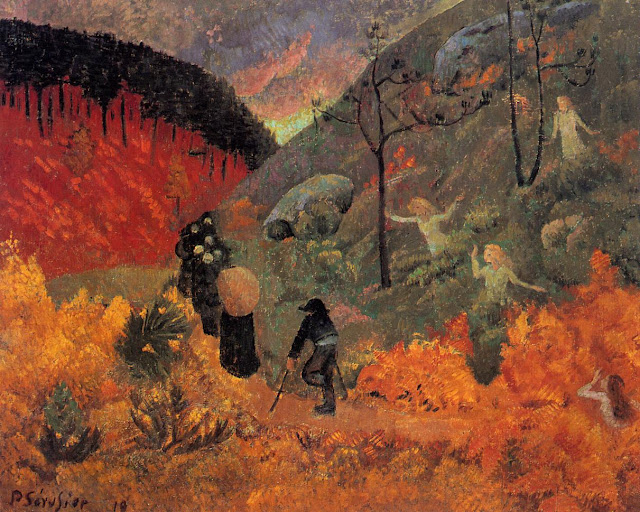 |
| Maurice Denis 1903 by Odilon Redon |
Following on from French artist Paul Sérusier, I’m taking a look at fellow artist and member of Les Nabis, Maurice Denis (1870 – 1943).
Denis received a classical education in the Lycée Condorcet where he met Vuillard, Roussel and Lugné-Poë. While studying in the Lycée he took drawing lessons and copied paintings by the old masters. In 1888 he enrolled at the Académie Julian and then at the Ecole des Beaux-Arts. In the same year painter Paul Sérusier showed his friends at the Académie Julian the famous landscape, which he had painted at the suggestion of Gauguin at Pont-Aven and which, for this reason, was considered a "talisman" of Gauguin's doctrine of Synthetism.
 | |
| Sérusier's The Talisman |
Denis joined the Nabis (a Hebrew word meaning 'prophets') and in 1890, in the review Art et Critique, he published his famous article in which he stated the artistic credo of the group. During this period he became associated with the Symbolist writers, illustrating the books of André Gide and Paul Verlaine's Sagesse, and designing front-pieces for Maurice Maeterlinck's Pelléas et Mélisande and for musical scores of Claude Debussy.
Like the other Nabis, Denis experimented in various fields of art, designing carpets, painting cartoons for stained-glass and mosaic panels, and decorating ceramics. The 1890s saw his first large-scale decorative works, the painted ceiling in the house of the French composer Chausson (1894) and a cycle of panels on the theme The Legend of St. Hubert (1897) in the house of the collector Cochin.
His early work as a painter is marked by originality, though he was strongly influenced by the art of the Italian Renaissance, especially after his trips to Tuscany and Umbria in 1895 and 1897. Though his paintings and mural decorations of subsequent years can now seem rather anaemic and sugary, his fame continued to grow. He received numerous commissions: from 1899 to 1903 he decorated the Church of Sainte-Croix at Vésinet; and in 1908-9 he was commissioned by Ivan Morozov, Russian industrialist and famous patron of art, to make a series of decorative panels, The Story of Psyche, which he brought to Moscow in January 1909 to install in Morozov's house.
In 1913, Denis did ceiling paintings for the Théâtre des Champs-Elysées; in 1917, he worked in the Church of St. Paul at Geneva; in 1924, he decorated the dome of the Petit Palais in Paris; and in 1928, he painted the ceiling above the staircase in the Senate building. Between 1936 and 1939, he did a number of decorative panels for the Palais des Nations in Geneva. In addition to his work as a painter, Denis was one of the most prominent art theoreticians of the time. His articles on contemporary art, published in various magazines, were later collected in Théories (1912) and Nouvelles theories (1922). Maurice Denis died in 1943.
Part 2 will look at more of Marice Denis’s paintings, and Part 3 at his delicate lithographs.
 |
| 1890 Bretons oil on canvas |
 |
| 1891 Easter Morning or Easter Mystery oil on canvas |
 |
| 1891 Eva Meurier in a Green Dress oil on canvas |
 |
| 1891 Princess Maleine's Minuet or Marthe Playing the Piano oil on canvas |
 |
| 1891 The Seasons Series, September or September Evening oil on canvas |
 |
| 1892 Regatta at Perros oil on canvas |
 |
| 1892 Rocks at Pouldu oil on board |
 |
| 1892 The Sleeper or Young Girl Asleep oil on canvas |
 |
| 1892 Wedding Procession oil on canvas © 2003 State Hermitage Museum |
 |
| c1892 Encounter oil on cardboard © 2003 State Hermitage Museum |
 |
| 1893 The Muses in the Sacred Wood |
 |
| 1894 Mary Visits Elizabeth |
 |
| 1894 Virginal Spring (Flowering Apple Trees) oil on canvas |
 |
| 1895 Mother and Child oil on canvas © 2003 State Hermitage Museum |
 |
| c1895 Furrows in the Snow |
 |
| 1896 Martha and Mary oil on canvas © 2003 State Hermitage Museum |
 |
| 1897 Figures in a Spring Landscape (Sacred Grove) oil on canvas © 2003 State Hermitage Museum |
 |
| 1897 Noele's First Steps oil on panel |
 |
| 1897 Portrait of Yvonne Lerolle |
 |
| 1899 Parisians at the Seaside, Evening oil on canvas |
 |
| 1899 Woman in Blue oil on paper |
 |
| 1899 Young Girl Wearing an Apron |








































